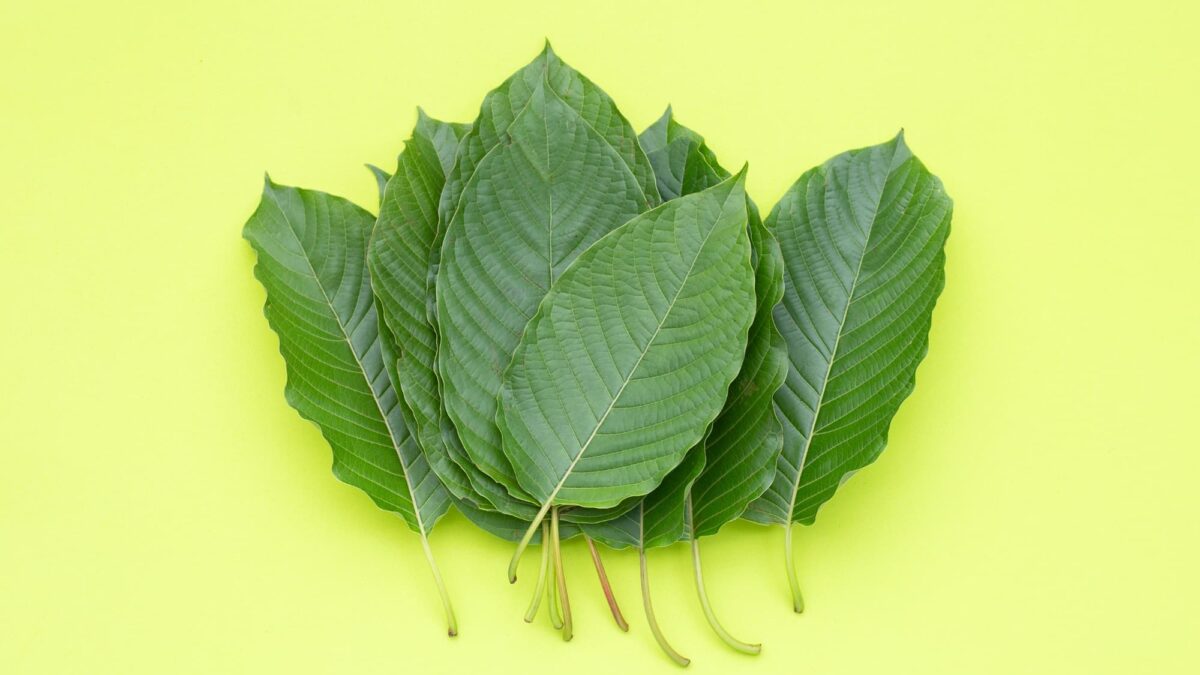
Does Kratom Get You High? Exploring the Plant’s Psychoactive Effects
July 4, 2024
The Science of Paynantheine: Potential and Possibilities in Kratom
July 16, 2024Kratom (Mitragyna speciosa; also known as krathom or ketum), a member of the coffee family, has been utilized for centuries in Southeast Asia for its medicinal properties.
Traditionally used to alleviate opioid withdrawal symptoms, pain, diarrhea, and cough, those who currently use kratom find that benefits include relaxation and pain alleviation, boosting energy, as well as easing anxiety and depression.
Historically, people used to consume kratom by chewing the raw leaves, brewing them into tea, smoking, or vaporizing them. Now that kratom’s popularity has spread beyond Asia, kratom leaves, powders, gums, capsules, and extracts are easily available through retail shops and online platforms across North America and Europe.
In the US, kratom is not FDA approved, therefore it is largely unregulated, posing safety concerns for the public. And because the media presents conflicting information about kratom, it’s difficult for clinicians and the public to make their own informed decisions.
Let’s take a closer look at the anecdotal testimony of people who benefit from kratom use as well as current research on the topic to shine a light on the positives and negatives, and where things might be headed for kratom’s future as a health and wellness botanical.

Why Do People Use Kratom?
People use kratom for various reasons, including pain relief, mood enhancement, anxiety reduction, opioid withdrawal management, and recreational use.
Pain relief: Kratom may be effective for chronic pain by attaching to opioid receptors, with one compound, 7-hydroxymitragynine, being 13 times more potent than morphine.
Mood enhancement and anxiety reduction: Early studies suggest kratom may have potential as an antidepressant and may help alleviate withdrawal symptoms of morphine and ethanol.
Opioid withdrawal management: Some people report using kratom to self-treat opioid withdrawal symptoms, but there is no approved use for this purpose.
Recreational use: Depending on the form and dose, kratom can produce stimulating effects like increased energy and alertness or relaxing effects.
One group that has been a strong kratom proponent is US veterans. Whenever the government has moved to ban or regulate kratom, veterans have had a strong voice in the conversation. , regulate, or better understand kratom.
Veterans have used kratom as an alternative to prescription opioids for pain management. They have also used kratom as a treatment for opioid withdrawal symptoms, which is particularly relevant given the ongoing opioid abuse epidemic in the U.S.
What Are Kratom’s Effects on the Body?
Kratom’s effects on the body are dose-dependent. At low doses, kratom acts as a stimulant, increasing energy, sociability, and alertness. Users report feeling more talkative, energetic, and having a more rapid heartbeat.
At higher doses, kratom produces opioid-like effects, interacting with opioid receptors in the brain to provide pain relief, sedation, and euphoria. One of kratom’s primary active compounds, 7-hydroxymitragynine, as mentioned above, has been found to be more potent than morphine.
While kratom offers potential benefits, it’s important to be aware of the possible side effects and risks.
Common side effects include nausea, constipation, dizziness, dry mouth, and increased urination. More severe risks, although rare, can include hallucinations, seizures, and liver damage. Long-term kratom use has been associated with weight loss, insomnia, and darkening of the skin.
Kratom’s Interactions in the Brain
Kratom’s effects on the brain are primarily attributed to its two active compounds: mitragynine and 7-hydroxymitragynine. These compounds bind to the body’s opioid receptors and produce a morphine-like effect.
While kratom targets the same receptors as traditional opioids like morphine and codeine, it is considered an atypical opioid. Kratom selectively inactivates specific signaling pathways, which may explain its more tolerable side effect profile compared to classical opioids.
However, like traditional opioids, kratom use can lead to dependence and withdrawal. Kratom withdrawal symptoms can include irritability, muscle aches, and insomnia. Despite these similarities, a systematic review suggests that kratom’s withdrawal symptoms are generally milder than those of opioids.
While more research is needed to fully understand kratom’s effects on the brain and body, current evidence suggests that it may have potential as an alternative for pain management and opioid withdrawal. However, its use should be approached with caution due to the risks of side effects, dependence, and the lack of regulation surrounding kratom products.
Does Kratom Lower Testosterone?
The study from the Journal of Ethnopharmacology looked into whether kratom, which is similar to opioids, could lower testosterone levels like other opioids often do.
Their research, in fact, concluded that regular use of kratom tea or juice, even over long periods (more than two years), doesn’t seem to affect testosterone or other key hormones like FSH and LH in regular users.
So, based on this study, if you’re consuming kratom regularly, it doesn’t appear to have the testosterone-lowering effects that are sometimes seen with typical opioid use.
Is Kratom Legal?
Kratom’s legal status varies by country and even by state within the United States.
In the U.S., kratom is currently legal at the federal level. However, 30 states have pending legislative measures pertaining to the sale of kratom, and six–Alabama, Arkansas, Indiana, Rhode Island, Vermont, and Wisconsin have outright banned the sale of kratom.
The U.S. Food and Drug Administration (FDA) has issued warnings against consuming kratom, citing concerns about the risk of addiction, abuse, and dependence (FDA, 2023). The Drug Enforcement Administration (DEA) has also classified kratom as a drug and chemical of concern.
Internationally, kratom is banned in several countries, including Australia, Denmark, Finland, Israel, Japan, Poland, Sweden, Turkey, and Vietnam. However, it remains legal or unregulated in many other countries, particularly in Southeast Asia, where the plant is native.
As kratom’s popularity continues to grow, its legal status remains a topic of ongoing debate and may be subject to change as more research is conducted and regulatory bodies assess its potential risks and benefits.
Kratom Interactions
Moderate Interactions: Exercise Caution
- Prescription Medications and Kratom: Kratom may interfere with the way the body processes certain medications, particularly those metabolized by liver enzymes CYP3A and CYP2D6. Many commonly prescribed drugs, such as some antidepressants, painkillers, and antibiotics, rely on these enzymes for proper metabolism. Taking kratom alongside these medications could lead to increased drug levels in the body, potentially causing unwanted side effects or toxicity.
- Drugs Affected by P-glycoprotein (P-gp) and Kratom: P-glycoprotein is a protein that helps regulate the absorption and distribution of various substances in the body. Some medications rely on P-gp to limit their entry into sensitive areas, such as the brain. Kratom alkaloids, especially mitragynine, may inhibit P-gp function, which could allow more of these drugs to enter the body and cause increased effects or side effects.
- Sedatives and Kratom: Both kratom and sedative medications, such as benzodiazepines (e.g., Xanax, Valium) or sleep aids, can cause drowsiness and slow breathing. Using them together may amplify these effects, potentially leading to difficulty breathing and excessive sleepiness.
- Antidepressants and Kratom: Some antidepressants, like venlafaxine (Effexor), work by increasing serotonin levels in the brain. Kratom may also affect serotonin levels. Combining kratom with these antidepressants could lead to a condition called serotonin syndrome, which can cause confusion, tremors, and other serious symptoms.
Minor Interaction: Monitor Closely
- Other Medications and Kratom: Kratom may also interfere with the metabolism of drugs processed by another liver enzyme called CYP2C19. While the impact may be less significant compared to CYP3A and CYP2D6, it’s still advisable to monitor for any unusual side effects when using kratom with medications that rely on this enzyme (Kamble et al., 2020b).
It’s crucial to remember that the potential for drug interactions with kratom is not limited to the examples provided above. As more research is conducted, additional interactions may be discovered. To stay safe, kratom users should always consult with their healthcare providers before combining kratom with any medications or substances.

Kratom Dosage
Kratom dosage is crucial to achieving the desired effects while minimizing the risk of side effects. The optimal dose varies from person to person, depending on factors such as body weight, tolerance, and the desired effects.
According to Kratom.org, a low dose of kratom (2-6 grams) typically produces stimulating effects, while a high dose (6-8 grams) tends to have sedative and pain-relieving properties. Microdoses (less than 2 grams) may provide mild stimulation with a low risk of side effects. It’s essential to start with a lower dose and gradually increase until the desired effects are achieved.
For pain relief, different dosages may be appropriate depending on the severity:
- Mild pain: 2-4 grams
- Moderate pain: 3-5 grams
- Severe pain: 5 grams or more (Kratom.org, 2023)
When using kratom for anxiety or depression, finding the right dose is crucial. Lower doses may be too stimulating and worsen anxiety symptoms, while excessive doses can cause side effects like the “kratom wobble” (dizziness, nausea, and loss of coordination). A common dose for anxiety is around 3-4 grams, with booster doses of 1 gram per hour as needed.
It’s important to note that the FDA has not approved kratom for any medical use, and there is no specific recommended dose.
Measuring kratom dosage by weight using a scale is more accurate than measuring by volume. Kratom powders can vary in grind size, affecting the amount that fits in a teaspoon or tablespoon.
While kratom rarely causes side effects when used conservatively, taking too much can lead to adverse reactions such as dehydration, dizziness, nausea, and poor coordination. To minimize the risk of side effects, users should start with a low dose, stay hydrated, and avoid combining kratom with other substances without medical guidance.
Is There a Sensible Path Forward with Kratom?
Implementing appropriate regulations, such as the Kratom Consumer Protection Act (KCPA), could help ensure consumer safety while allowing for responsible use and continued research.
Education plays a vital role in empowering consumers to make informed decisions about kratom use, promoting responsible use and reducing adverse effects. Continued research is key to unlocking kratom’s potential and addressing current knowledge gaps, paving the way for evidence-based policies and informed consumer choices.
While the current state of knowledge on kratom’s safety and potential is limited, there are reasons for cautious optimism. Risks such as addiction and adverse effects cannot be ignored, but promising findings related to pain relief, anxiety reduction, and opioid withdrawal support suggest that kratom may have a role to play in addressing important public health challenges.
A balanced, evidence-based approach to kratom policy and regulation, informed by scientific evidence, user experiences, and medical insights, can prioritize consumer safety, encourage responsible use, and support ongoing research. By investing in further research and committing to science, education, and responsible regulation, we can harness kratom’s potential while minimizing its risks, ultimately improving public health outcomes.
For Further Reading
- Anand, Abhisheak, and Anuja Hosanagar. “The addictive potential and challenges with use of the “herbal supplement” kratom: a case report and literature review.” Researchgate.net April 2021.
- Benisek, Alexandra. “Health Benefits of Kratom.” WebMD. 1 Feb. 2023
- Brogdon, Hazel, et al. “A case of potential pharmacokinetic kratom-drug interactions resulting in toxicity and subsequent treatment of kratom use disorder with buprenorphine/naloxone.” NIH.gov. 14 Feb. 2022
- Deer, Marcel. “Is Kratom Legal? A Global Analysis (2023).” Kratom.org. 2023
- Guidry, Kelley. “Opinion: Pain-relieving kratom has great promise for disabled vets. It should be regulated fairly.” The San Diego Union-Tribune. December 6, 2023.
- Hanapi, Nur Aziah. “Kratom Alkaloids: Interactions With Enzymes, Receptors, and Cellular Barriers.” NIH.gov. 17 November, 2021
- Henningfield, Jack E. “Kratom withdrawal: Discussions and conclusions of a scientific expert forum.” NIH.gov. 7 June 2023
- Kamble, Shashikant H., et al. “Exploration of cytochrome P450 inhibition mediated drug-drug interaction potential of kratom alkaloids.” NIH.gov. Feb. 2021
- “Kratom – Uses, Side Effects, and More.” WebMD. 2023
- “Kratom.” NIDA. March 2022
- Paul, Wade. “Kratom Dosage Guide — How Much Kratom Should I Take?” Kratom.org. 2023
- Roth, Christine. “Study Pokes Holes in Kratom’s ‘Bad Rap.” Rochester.edu. 13 December 2017
- Silva, Lauren. “What Is Kratom? Uses, Side Effects And More.” Forbes. 5 Jan. 2024.
- Swogger, Marc T., and Zach Walsh. “Kratom use and mental health: A systematic review.” ScienceDirect.com. 1 February 2018
- Tanna, Rakshit S. “Translating Kratom-Drug Interactions: From Bedside to Bench and Back.” NIH.gov. August 2023




